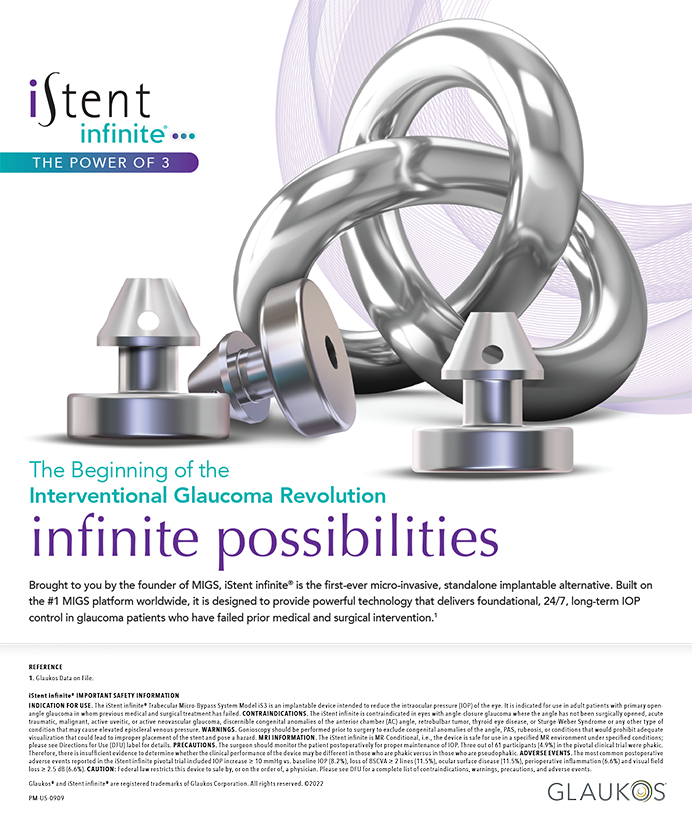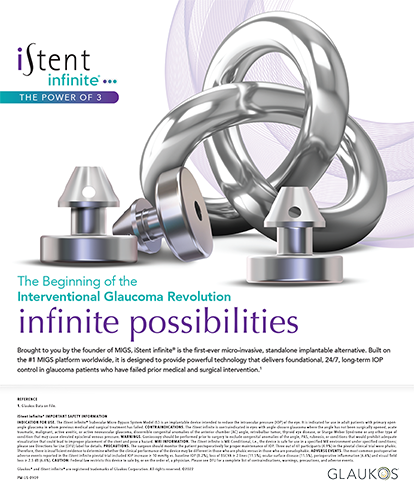Since radial keratotomy's (RK) introduction more than 30 years ago, a conservative estimate is that more than 40 million people worldwide have undergone some form of keratorefractive surgery. According to Market Scope (St. Louis, MO), more than 8.5 million people (15 million eyes) in the United States alone had undergone laser-based refractive surgery as of June 30, 2011. An ever-increasing number of these individuals now need cataract surgery.
Anyone who routinely performs lens-based surgery after refractive surgery or who counsels patients for the procedure is well aware that these individuals are highly invested in a specific refractive outcome. The very procedure that decreased their dependence on spectacles, however, places certain limitations on current technology. After all forms of refractive surgery, eye care specialists are unable to accurately measure central corneal power using standard techniques. In addition, the almost universal presence of increased higher-order aberrations may decrease these patients' IOL options. Moreover, unmodified theoretical formulas are ill suited to the task of IOL power calculations. The potential result is something of a refractive tsunami that will soon wash over eye care.
RADIAL KERATOTOMY
To estimate the central corneal power after RK, using the Atlas Corneal Topography System (Carl Zeiss Meditec, Inc.) to obtain (1) the average of the 1- through 4-mm annular power values from the Numerical View of models 995, 994, or 993 or (2) the average of the 1- through 4-mm ring values of the model 9000 generally gives good results (Figure 1). This is also the methodology employed by the American Society of Cataract and Refractive Surgery (ASCRS) online postkeratorefractive surgery IOL power calculator, which I highly recommend (see The ASCRS Calculator). Unpublished data reviewed in my clinic during the past year suggest that the Power Distribution feature of the Pentacam Comprehensive Eye Scanner (Oculus Optikgeräte GmbH) at a 5-mm zone centered on the pupil also works well for the estimation of central corneal power for eyes with prior RK (Figure 2). All estimating techniques, however, are generally less accurate when a post-RK cornea is significantly multifocal or there is a strong demarcation between steep and flat areas near the pupillary center.
The combination of progressive corneal flattening (hyperopic drift) and small or large amounts of lenticular myopia may mask the true refractive corneal power when the eye care specialist uses historical methods for estimation. For this reason, approaches based on clinical history may not be useful after RK. For example, years of experience have shown me that the contact lens method, even with a reverse-geometry rigid gas permeable lens, is not consistently accurate.
IOL power calculations after RK cannot be carried out successfully using routine methods of corneal power measurement and an uncorrected or unmodified thirdgeneration, theoretical, two-variable formula. Required instead is the correctly estimated corneal power combined with an Aramberri double-keratometry (K) method correction of the Hoffer Q, Holladay 1, or SRK/T formula; the internal double-K method correction of the Holladay 2 formula; or a formula that is not affected by the artifact of flat, central Ks such as the Haigis formula. The ASCRS online postkeratorefractive surgery IOL power calculator uses an Aramberri double-K method, specially modified version of the Holladay 1 formula.
Because hyperopic drift after RK may persist for decades, refractive outcomes are generally targeted for somewhere between -0.50 and -0.75 D. This is for two reasons. First, unanticipated hyperopic errors are common. Second, it is more desirable to have the patient's refraction shift over time toward something better (plano) than away from what he or she wants. Hard plano, therefore, should never be the refractive target after RK.
Despite eye care specialists' best efforts, the final refractive objective may remain elusive after cataract surgery in an eye that underwent RK. In such cases, an IOL exchange or piggyback IOL should not be planned until the patient's postoperative refraction stabilizes. In general, at least 2 months must pass, and two refractions must be stable at two consecutive visits at approximately the same time of the day (sometimes referred to as the post-RK rule of 2s).
MYOPIC LASIK
Estimating the central corneal power after myopic LASIK is less straightforward than after RK. A wide variety of methods involve historical changes, autokeratometry correction algorithms, and the adjustment of topographic data (Figures 3 and 4). The Masket and modified Masket methods use small-zone autokeratometry and a linear correction algorithm that adjusts the measured central corneal power based on the amount of prior refractive surgery. Modified Masket is one of the more accurate methodologies.1
Once considered the gold standard, the historical method after myopic LASIK appears to have one of the lowest overall accuracies. Unfortunately, it is an increasingly common occurrence for patients no longer to have access to their refractive surgery records. When this is the case, the Shammas and Haigis-L methods can be very useful. Both formulas adjust the measured central corneal power, and both are free of the calculation artifact that typically occurs with theoretical formulas in the setting of very flat or very steep corneal power values.
HYPEROPIC LASIK
The estimation of central corneal power after hyperopic LASIK may involve historical changes, autokeratometry correction algorithms, and the adjustment of topographic data. In general, the accuracy of calculations after hyperopic LASIK is somewhat better than after myopic LASIK. Hyperopic patients typically receive smaller amounts of refractive correction, and the measurement error by small-zone autokeratometry is relatively small compared with myopic LASIK. Treatment regression, however, combined with lens-induced myopia may render the historical method inaccurate. As with myopic LASIK, the Masket, modified Masket, and Haigis-L methods give good overall results; the Haigis-L is very useful when there are no prior refractive surgery data for review.2
IOLs
The primary feature of refractive surgery is a change in central corneal power. The naturally occurring positive spherical aberration of the cornea typically increases after RK and myopic LASIK and decreases after hyperopic LASIK. Ophthalmologists should bear this in mind when selecting an IOL so that the lens does not accentuate the change in spherical aberration produced by refractive surgery, further reducing contrast sensitivity.
Eyes with prior RK, or myopic LASIK, generally do better with an aspheric IOL that adds negative spherical aberration (AcrySof IQ lens [Alcon Laboratories, Inc.] or Tecnis 1-Piece lens [Abbott Medical Optics Inc.]). Eyes that previously underwent hyperopic LASIK do well with spherical aberration neutral IOLs (Sofport AO lens, model LI61AO [Bausch + Lomb]) or spherical IOLs after large amounts of hyperopic correction. Ideally, the anterior corneal spherical aberration should be measured as part of this decision-making process.
After refractive surgery, toric IOLs are generally contraindicated when an anterior corneal topographic map demonstrates irregular astigmatism. Similarly, multifocal IOLs are contraindicated in eyes with irregular astigmatism or obviously multifocal corneas with increased higher-order aberrations, especially spherical aberration and coma. In this setting, a multifocal lens is likely to degrade visual function due to a loss of contrast sensitivity.3
This article is reproduced with permission from the November/December 2011 edition of Advanced Ocular Care.
Warren E. Hill, MD, is in private practice at East Valley Ophthalmology in Mesa, Arizona. He stated that he holds no proprietary interest in any of the items mentioned herein, but he is a consultant to Alcon Laboratories, Inc. Dr. Hill may be reached at (480) 981-6130; hill@doctor-hill.com.
- Wang L, Hill WE, Koch DD. Evaluation of IOL power prediction methods using the ASCRS post-keratorefractive IOL power calculator. J Cataract Refract Surg. 2010;36:1466-1473.
- Haigis W. L-formula—IOLMaster approach. Paper presented at: XXVI Congress of the ESCRS; September 13, 2008; Berlin, Germany.
- Hamza I, Aly MG, Hashem KA. Multifocal IOL dissatisfaction in patients with high coma aberrations. Presented at: ASCRS Symposium on Cataract, IOL and Refractive Surgery; March 27, 2011; San Diego, CA.


